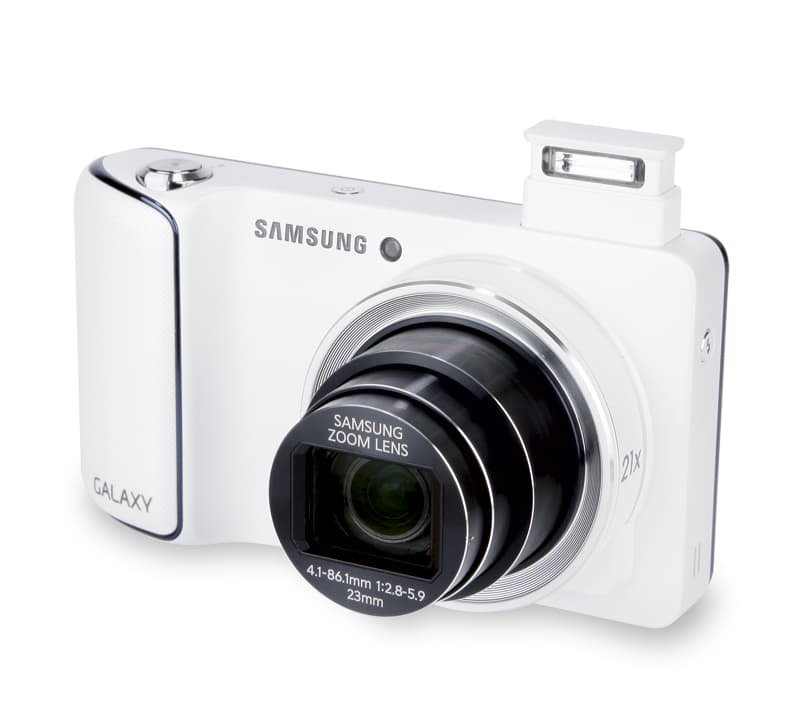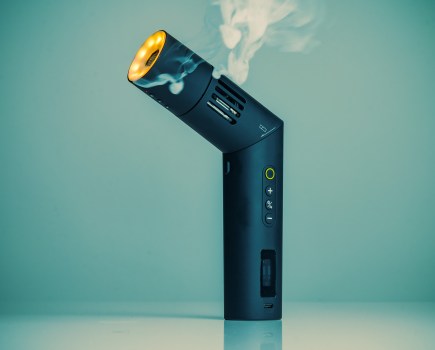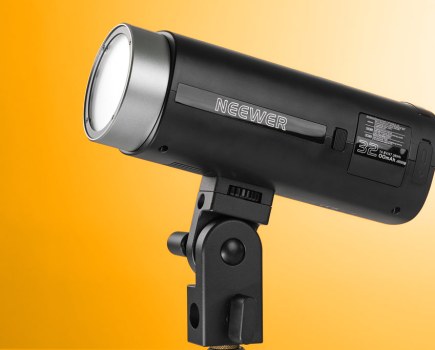Samsung Galaxy Camera at a glance:
- 16.3-million-pixel, 1/2.33in, CMOS sensor
- Schneider-Kreuznack 4.1-86.1mm (23-483mm full-frame equivalent) f/2.8-5.9 lens
- ISO 100-3200
- 4.8in, 1280×720-pixel resolution touchscreen
- Street price around £395
Samsung Galaxy Camera review – Introduction
It may not be the first camera to have Wi-Fi, or even the first camera to have an Android operating system, but the £399 Samsung Galaxy Camera is the best example yet of what happens when mobile computing and camera technology collide. In the past few years we have seen camera phones become more popular and their image quality improve dramatically, but the Samsung Galaxy takes things one step further. Rather than being a phone with a small built-in camera, the Galaxy is a fully fledged compact camera with a wealth of smartphone technology built in.
What differentiates the Samsung Galaxy Camera from the Nikon Coolpix S800c (which is also Wi-Fi-enabled and features an Android operating system) is that the Galaxy allows 3G/4G data connection. This is the same type of connection found in mobile phones and tablets to send and receive data. What this means is that the Galaxy no longer needs a Wi-Fi hotspot to send images. Instead, it can send them anywhere a 3G/4G mobile-phone signal can be received.
However, it can do much more than that. With a huge range of additional applications that can be downloaded, the Galaxy is, in effect, a small computer that can provide additional support and tools for the photographer.
Although at present the Samsung Galaxy Camera is clearly aimed at a consumer market rather than at keen enthusiast photographers, it is possible that we could soon see such features on a more advanced compact camera, or even on a DSLR. Yet despite all the technology packed into the Galaxy it is still a camera, so image quality and handling are the main considerations. I was keen to find out whether there were any compromises made with the introduction of this latest technology.
Features
Essentially, the Galaxy is a hybrid version of the Samsung WB850 compact camera and the Samsung Galaxy S3 smartphone. At the core of the Galaxy is a 1/2.33in, 16.3-million-pixel, CMOS imaging sensor, which is the same size and approximately the same resolution as the sensor of the WB850. Also the same is the Schneider-Kreuznack 4.1-86.1mm (23-483mm full-frame equivalent) f/2.8-5.9 21x optical zoom lens. This lens is optically stabilised to reduce camera shake, which is needed when using long focal lengths.
Unlike other camera manufacturers that brand their processing units with names such as Expeed, Digic or Bionz, the Galaxy has it roots deep in the electronics and computing industries, with a 1.4GHz quad-core CPU, which is the same as that used in the S3 smartphone. Like the S3, the quad-core processor is used to power the Galaxy’s features and operating system, which is the recent Jelly Bean version of Google’s Android. If all this means very little to you, see Connectivity for an explanation.
While most mobile phones use LED lights to illuminate a dark scene, the Galaxy has an almost identical pop-up flash to that used on the WB850. There is little else in terms of external features. A 3.5mm jack socket on the side allows headphones or a microphone to be attached, while a micro HDMI socket is found on the bottom of the camera.
The battery that powers the Galaxy is the same as that used in the Galaxy S2 smartphone. Samsung claims this should allow around 250 images to be taken. However, given the sheer number of other features found in the camera, it is highly unlikely that most photographers will ever use this number. Thankfully, the camera is readily available. Another useful characteristic, given the relatively high power consumption of the camera, is the fact that it can be powered via a micro-USB socket on the side. This allows the Galaxy to be charged via any USB connection, including the many external battery packs that are now available.

Image: The powerful 21x optical zoom and excellent image stabilisation make the Galaxy a powerful camera for snapshot wildlife images
Connectivity

Image: The Android operating system allows you to completely customise the extra features of the Galaxy Camera
The samsung Galaxy Camera is laden with technology more commonly found on mobile phones and tablet computers, but what does it all do?
Wi-Fi
A Wi-Fi-compatible camera can be connected wirelessly to either an internet hotspot, or to another device such as a mobile phone or a computer.
When connected to a Wi-Fi hotspot, cameras can send images via email or upload them to the internet so they can be seen on social networking sites such as Facebook. More importantly, Wi-Fi can allow images to be archived to an online storage account. The Galaxy Camera comes with 50GB of online Dropbox space for two years. This means that thousands of images can be automatically saved in a secure online account and then accessed via a computer or mobile phone anywhere in the world.
Wi-Fi also usually allows remote live view and triggering of the camera’s shutter via another device, such as a smartphone. This is useful for wildlife shots, self-portraits or just capturing
an image in an awkward location.
3G and 4G
These are mobile data bandwidths used to send and receive data. It is the same technology found in mobile phones, and means you can send or receive data without using a Wi-Fi connection. The Galaxy is the first consumer compact camera to have this technology built in. It gives users the potential to send images around the world while, say, standing in the middle of a field. It can also help photographers by allowing data from apps to be received.
A mobile phone SIM card for the Three network is included in the Galaxy package. It allows up to 1GB of data to be sent or received over a 30-day period. After this time, you can continue to use the mobile data by topping up the card, or by using your own SIM card and mobile data contract.
The Galaxy Camera doesn’t require a mobile SIM card to operate. It will work with just a Wi-Fi connection if you don’t want to use 3G/4G connectivity.
Android
Nikon’s Coolpix S800c was the first camera to have the Android operating system, but the large screen of the Samsung Galaxy Camera makes it a much more usable proposition.
While the obvious benefit to photographers is the ability to use the various apps to share images online, it also means that photographers can perform basic image editing with programs like Snapseed or Photoshop Touch.
However, there is a lot more available. For example, an app such as Lapse-It instantly adds time-lapse functionality, while the Photographer’s Ephemeris enables photographers to check the position of the sun or moon at a specific time when planning a landscape shoot. Notes can be taken about specific locations, and you can check where images have been taken using Google Maps. Images can be emailed straight from the camera, or you can even do something trivial like download the Tune-In radio app or watch a TV show.
In effect, the camera becomes a computer that you can customise to your requirements. All this is wonderful, but remember that there will be extra drain on the battery so buy a spare.
Build and handling
The defining feature of the Samsung Galaxy’s build is its 4.8in, 1280×720-pixel resolution touchscreen. This is the same screen as that featured on the Galaxy S3 mobile phone. With such a big screen the Galaxy is slim, but also tall and wide. It is almost as wide and as tall as the Nikon Coolpix P7700. However, this does provide space for a comfortable rubber-coated handgrip on the front of the camera.
Nearly all the features of the Galaxy are controlled via the camera’s touchscreen display. The only buttons on the camera are the power button, shutter release, flash release and the zoom toggle switch. This sparse button arrangement dramatically affects the way the camera operates.
With no thumb rest on its rear, it can seem a little awkward to grip the Galaxy comfortably in the hand. I found that it was best to hold it with my left thumb and forefinger around the lens barrel, as if using a system camera. The lack of a thumb rest also means that you must get used to resting your thumb on the screen, which can slightly obstruct the image. An on-screen shutter/focus-lock button also helps to direct the thumb to a comfortable position to rest on the screen.
Like the WB850, there is a full complement of exposure modes, including manual, aperture and aperture priority. Pressing a virtual mode dial changes the modes. If one of the manual-exposure modes is selected, the ISO sensitivity, aperture, shutter speed and exposure compensation appear in an on-screen menu. Using a finger on the screen allows the various settings to be scrolled through. Alternatively, the exposure setting you wish to change can be pressed on-screen, which then displays the relevant setting to change. This is slower than using a basic button arrangement on a conventional compact camera.
While the Galaxy is straightforward and intuitive to use, it is too slow. The touchscreen is as sensitive as those found on mobile phones, and Samsung has done a good job of incorporating the best of its mobile technology into the camera. It is just a shame that the company didn’t take more from its camera range and use it in the Galaxy. The camera would be significantly improved for enthusiast photographers if it included the iFunction technology that is found on Samsung’s NX lenses. A simple button on the side of the lens or camera, with a control ring around the lens, would allow users to scroll through the settings quickly, then change the one they wanted.
Performance

These images show 72ppi (100% on a computer screen) sections of images of a resolution chart, captured with the lens set to its 100mm point. We show the section of the resolution chart where the camera starts to fail to reproduce the lines separately. The higher the number visible in these images, the better the camera’s detail resolution is at the specified sensitivity setting.
One of the best things about the Samsung Galaxy Camera is its large screen. It is superb. Having so much room to compose images gives you a far better idea of how the image will look on-screen or when printed. When viewing images, it is also great to be able to comfortably show off images to friends – and all this without even mentioning the space the screen offers when using the various applications.
As with most compact cameras of this type, it is not possible to save images as raw files, although there are three levels of JPEG compression.
Unfortunately, the image quality is not what we would expect from a 16-million-pixel travel zoom camera. Looking at images at 1:1 magnification, one can clearly see that even pictures taken at low sensitivities are lacking in fine detail. The level of JPEG compression is too high, and there appears to be some very aggressive luminance noise reduction taking place.
Above ISO 400 the image quality starts to break down, and although there is little in the way of image noise there is virtually no detail, as can be witnessed from our resolution-chart images. With no raw-shooting option, the Galaxy will not meet the demands of the enthusiast photographer, unless images are only viewed on-screen or printed at small sizes. Colour rendition is also a bit hit and miss, with the AWB settings occasionally producing images with a magenta cast. Thankfully, though, there is a small range of white balance settings, along with a custom setting option.
As for the lens, the large 21x optical zoom is superbly stabilised, which is something evident on the large rear screen. Having such a wide focal range makes the Galaxy a great travel camera, particularly when combined with its connectivity features. Clearly a younger audience who share images with social networking sites to create a virtual scrapbook of their lives will enjoy using the camera.

Image: The AWB sometimes struggles and colours don’t always look quite as good on-screen as they do on the camera. Here there is a slight magenta tint
Our verdict
The ability to share images instantly is a fairly new phenomenon, but one that is slowly changing how photographs are viewed and taken. Samsung has done an excellent job combining its camera and smartphone technology into a single product in the form of the Samsung Galaxy Camera, and it will appeal to many consumers who wish for that instant gratification.
Sadly, the image quality doesn’t match the expectations of enthusiast photographers, and the handling of the camera is slow. This could be easily rectified with the addition of a couple of discreet buttons or controls, and less noise reduction and image compression.
What the Galaxy does offer photographers is a lot of fun. The variety of different applications makes it a very versatile tool, and as a simple point-and-shoot compact camera it is an exciting alternative option.








